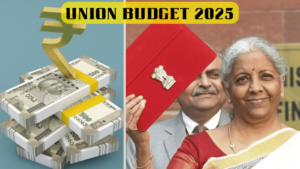Budget 2025 offers major tax relief to the middle class, including zero tax on incomes up to ₹12 lakh. However, it misses out on incentives for long-term savings and deductions. Read this detailed analysis of the hits and misses of Budget 2025 for middle-class taxpayers.

The Union Budget 2025, presented by Indian Finance Minister Nirmala Sitharaman, has brought a mixed bag of surprises for the middle class. While the revised tax slabs and exemption limits provide much-needed relief, the absence of incentives for savings and investments raises concerns.
One of the biggest highlights of the budget is the introduction of a zero tax on incomes up to ₹12 lakh, benefiting salaried employees and professionals alike. However, financial experts point out that while the tax burden has been reduced, the lack of deductions for long-term investments like Public Provident Fund (PPF), National Pension System (NPS), and Equity-Linked Savings Schemes (ELSS) under the new tax regime could discourage savings.
This blog provides an in-depth analysis of how Budget 2025 impacts middle-class taxpayers, outlining the major benefits and drawbacks.
The Hits: Big Wins for Middle-Class Taxpayers
Budget 2025 has introduced several key measures that significantly ease the tax burden for salaried employees and middle-income earners. Here are the most notable advantages:
1. Zero Tax on Incomes up to ₹12 Lakh
The biggest takeaway from Budget 2025 is the complete tax exemption on incomes up to ₹12 lakh under the new tax regime. Additionally, salaried employees receive a ₹75,000 standard deduction, effectively raising the tax-free income threshold to ₹12.75 lakh.
This is a major step toward simplifying taxation, as individuals in this income bracket will no longer have to worry about tax planning or filing deductions to reduce their tax liability.
2. Increased Basic Exemption Limit
The basic exemption limit has been raised from ₹3 lakh to ₹4 lakh, further reducing the tax burden for lower-income individuals. This revision ensures that those earning slightly above the exemption limit will also benefit from reduced tax payments.
3. Expanded Tax Slabs for More Relief
Budget 2025 has widened tax slabs, making tax payments more structured. The revised tax brackets benefit individuals across various income levels, ensuring a fairer tax distribution.
4. Higher TCS Threshold on Foreign Remittances
For individuals transferring money overseas under the Liberalised Remittance Scheme (LRS), the threshold for withholding Tax Collected at Source (TCS) has been increased from ₹7 lakh to ₹10 lakh.
This move is particularly beneficial for those sending money abroad for travel, business, or personal reasons, as it reduces the immediate tax liability on such transactions.
5. No TCS on Education Loans for Foreign Studies
To ease the financial burden on families funding higher education abroad, Budget 2025 removes TCS on education remittances where the funds come from an education loan obtained from a recognized financial institution.
Previously, even students taking loans for education abroad had to bear 0.5% TCS on remittances, which has now been eliminated.
6. Higher TDS Exemption for Senior Citizens
Senior citizens who rely on fixed deposits for income will benefit from the increased Tax Deducted at Source (TDS) threshold, which has been raised from ₹10,000 to ₹50,000.
This change simplifies tax compliance for retirees, ensuring that they do not have to deal with unnecessary deductions on their interest income.
7. Extension of NPS Benefits
The ₹50,000 tax deduction under Section 80CCD(1B) for National Pension System (NPS) contributions has now been extended to NPS Vatsalya under the old tax regime. This move provides additional retirement savings options to individuals looking for secure post-retirement income.

The Omissions: What Budget 2025 Failed to Address
While Budget 2025 is largely beneficial for middle-class taxpayers, there are certain areas where it falls short. Here are some significant drawbacks:
1. No Restoration of Indexation Benefit for Debt Funds
Investors in debt mutual funds were hoping for the return of indexation benefits on capital gains made before April 1, 2023. However, the budget did not restore this benefit, making debt mutual fund investments less attractive in comparison to fixed deposits and other fixed-income securities.
2. No Incentives for Long-Term Savings
A major concern among financial experts is that the new tax regime lacks provisions for long-term savings and investments. Unlike the old tax regime, which encouraged disciplined savings through Section 80C deductions, the new system does not provide any incentives for investing in:
Public Provident Fund (PPF)
Equity-Linked Savings Scheme (ELSS)
National Pension System (NPS)
Life insurance premiums
This move could discourage taxpayers from setting aside money for future financial security.
3. No NPS Contribution Benefit for the Self-Employed
Currently, employer contributions to employees’ NPS accounts (up to 14% of basic pay) are allowed as deductions under the new tax regime. However, self-employed individuals do not receive similar benefits.
Experts argue that the government should have extended the ₹50,000 deduction under Section 80CCD(1B) from the old regime to self-employed individuals under the new regime as well.
4. No Relief for PAN-Aadhaar Linkage Compliance
Employees who have not linked their PAN with Aadhaar continue to face a higher TDS deduction of 20% instead of 10%. Many tax professionals had expected the government to waive this requirement, particularly for low-income earners, but no such relief has been provided.
5. No Additional Deduction for Health Insurance
With rising healthcare costs and increasing health insurance premiums, many taxpayers expected that the Section 80D deduction for medical insurance would be incorporated into the new tax regime.
Unfortunately, the budget does not include any provisions for health insurance deductions under the new system, making it less attractive for those seeking comprehensive financial security.
What Should Middle-Class Taxpayers Do Next?
With these significant tax changes in place, salaried employees and middle-class taxpayers should carefully assess their tax-saving options. Here’s what you can do:
1. Compare the New and Old Tax Regimes
If you have major deductions under PPF, NPS, ELSS, and life insurance, consider sticking to the old tax regime for better savings.
If your annual income is below ₹12 lakh, opting for the new tax regime is the better choice, as it offers zero tax liability.
2. Reassess Investment Strategies
With fewer tax-saving incentives, consider investing in diversified assets like index funds, gold ETFs, and fixed deposits to ensure financial stability.
3. Ensure PAN-Aadhaar Compliance
To avoid a higher TDS deduction (20%), make sure to link your PAN with Aadhaar before the deadline.
4. Plan for Healthcare and Retirement
Since health insurance deductions are unavailable under the new tax regime, budget for health expenses separately and consider alternative retirement planning options.
Final Thoughts: A Balanced Approach but Room for Improvement
Budget 2025 provides substantial tax relief for middle-class individuals, particularly those earning up to ₹12 lakh. However, the lack of incentives for long-term savings, no deductions for healthcare expenses, and continued TDS compliance burdens leave room for improvement.
While the new tax regime simplifies the taxation process, taxpayers must carefully analyze whether it is the best choice for their financial goals. Ultimately, balancing immediate tax savings with long-term financial security will be key for middle-class earners in 2025 and beyond.
Would you prefer the new tax regime, or will you continue with the old tax structure? Let us know in the comments!
Read More

The Psychology of Love: Why Valentines Day Matters More Epic Than You Think
Discover the psychology of love and why Valentines Day is more important than you think. Learn how love impacts the brain, strengthens relationships, and boosts

Premier League Highlights: Arsenal Humiliate Man City 5-1, Spurs and Palace Secure Crucial Wins
Arsenal demolished Manchester City 5-1 in a statement premier league highlights win, reigniting their title hopes. Meanwhile, Crystal Palace stunned Man United 2-0, and Tottenham

How Budget 2025 Impacts the Indian Middle-Class: Major Tax Benefits and Glaring Omissions
Budget 2025 offers major tax relief to the middle class, including zero tax on incomes up to ₹12 lakh. However, it misses out on incentives

Degrees vs Employability: Why “Highly Qualified Degree Holders” Struggle to Find Jobs While “Less Qualified Individuals” Get Hired Faster!
Many highly qualified individuals struggle to secure jobs, while less qualified candidates get hired quickly. This Degrees vs Employability paradox is caused by employer preferences,

The Power of Mindset: Why Looking Poor Doesn’t Make You Poor, but Thinking Poor Does!
Discover why looking poor doesn’t define your wealth but thinking poor does. Learn the power of mindset and how a growth-oriented mindset can lead to

Overthinking: How It’s Damaging Today’s Youth – Causes and Cure in 2025
Understanding how overthinking is silently damaging today’s youth, from its causes rooted in societal pressure and social media to its long-term effects on mental health.
